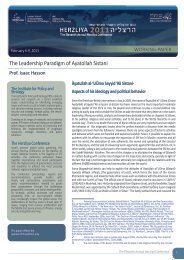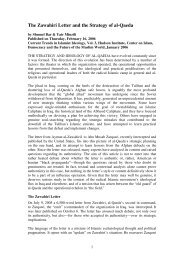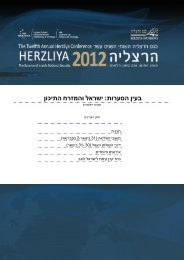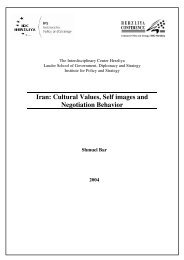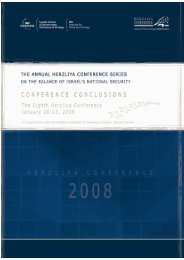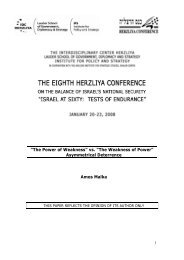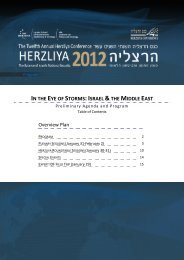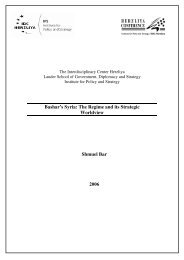Classical Islamic Paradigms of Deterrence and their Expression in ...
Classical Islamic Paradigms of Deterrence and their Expression in ...
Classical Islamic Paradigms of Deterrence and their Expression in ...
Create successful ePaper yourself
Turn your PDF publications into a flip-book with our unique Google optimized e-Paper software.
deterrence strategies, especially when a multiplicity <strong>of</strong> state <strong>and</strong> non-state actors are occupy<strong>in</strong>g the samefield. New-old forms <strong>of</strong> deterrence are re-emerg<strong>in</strong>g which draw on the most tribal <strong>in</strong>st<strong>in</strong>cts <strong>and</strong>mythological fears <strong>of</strong> human societies. <strong>Classical</strong> <strong>Islamic</strong> deterrence rituals <strong>and</strong> tribal martial behavior aretransformed <strong>in</strong>to analogue virtual actions. For example, big-lettered <strong>Islamic</strong> formulas <strong>of</strong> laudation on jihadidiscussion forums serve as virtual counterpart for physical threat behavior, thus be<strong>in</strong>g an expression <strong>of</strong>psychological <strong>and</strong> neo-tribal deterrence <strong>in</strong> virtual space.The first part <strong>of</strong> the research analyses different psychological states <strong>of</strong> fear as well as the construction <strong>of</strong>fear <strong>and</strong> deterrence <strong>in</strong> Islam. It concludes that <strong>Islamic</strong> deterrence strategy is based on a synthesis <strong>of</strong> thedifferent fear concepts. Muslims are supposed to feel a general fear to observe God’s comm<strong>and</strong>s (khauf)<strong>and</strong> to feel awe from div<strong>in</strong>e punishment if they do not give support to deterrence (ittiqa'), which takes thethe form <strong>of</strong> terrorist attacks. A threat scenario must be created to deter the enemy (ra'b; irhab). <strong>Islamic</strong>deterrence itself is called rad'. This term does not appear <strong>in</strong> the Qur'an, but <strong>in</strong> later texts. (The Sunna <strong>and</strong>its literary form hadith; as well as <strong>in</strong> the different str<strong>and</strong>s <strong>of</strong> <strong>Islamic</strong> jurisprudence fiqh). Modern jihadiideologues have condensed this concept <strong>in</strong>to a deterrence by punishment strategy, call<strong>in</strong>g it "terroristdeterrence strategy" (istiratijiyat al-rad' bi-l-irhab).The second part <strong>of</strong> the research deals with classical concepts <strong>of</strong> <strong>Islamic</strong> deterrence <strong>in</strong> the Qur'an, <strong>Islamic</strong>tradition <strong>and</strong> theology. Early <strong>Islamic</strong> scripts, as well as different branches <strong>of</strong> medieval <strong>Islamic</strong> theology show– similar to the monotheistic religions Judaism <strong>and</strong> Christendom – clear ideas <strong>of</strong> punishment, or the threat<strong>of</strong> punishment for the sake <strong>of</strong> prevent<strong>in</strong>g hostile actions from adversaries <strong>and</strong> for secur<strong>in</strong>g <strong>their</strong> own group.Intra-religious similarities become clear when look<strong>in</strong>g at the Old Testament, where God revealed to Mosesafter Joshua’s fight aga<strong>in</strong>st the Amaleks that "I will utterly put out the remembrance <strong>of</strong> Amalek from underheaven" (Exodus 17, 14), <strong>and</strong> the destruction <strong>of</strong> the Anakims at the h<strong>and</strong>s <strong>of</strong> Joshua (Joshua 11:21-23) withthe goal that "the l<strong>and</strong> rested from war." These passages can be read as div<strong>in</strong>e <strong>in</strong>junctions to secure theown group by show<strong>in</strong>g a sacred form <strong>of</strong> strength <strong>and</strong> power, which follows "div<strong>in</strong>e <strong>in</strong>junctions." The threatto be annihilated <strong>in</strong> case <strong>of</strong> an attack is a powerful mythological theme that can be used aga<strong>in</strong>st anadversary. The cost-benefit calculation <strong>in</strong> the m<strong>in</strong>d <strong>of</strong> a possible enemy from the out-group can preventhim from an attack. This k<strong>in</strong>d <strong>of</strong> mythology may also f<strong>in</strong>d a practical release valve <strong>in</strong> the systemic creation<strong>of</strong> fear with<strong>in</strong> the <strong>in</strong>-group. The Catholic Church used the Inquisition to suppress any deviant views <strong>and</strong>bolster its monopoly on the <strong>in</strong>terpretation <strong>of</strong> Christian faith through a policy <strong>of</strong> deterrence <strong>and</strong><strong>in</strong>timidation.Examples that clearly show the roots <strong>of</strong> classical <strong>Islamic</strong> deterrence paradigms <strong>and</strong> <strong>their</strong> importance formodern salafi-jihadis are, for example, Muslim raids aga<strong>in</strong>st Meccan merchant caravans <strong>in</strong> the 7th centurythat took place from the Muslim stronghold <strong>in</strong> Med<strong>in</strong>a. These raids seem not to have been motivated byeconomic reasons only. Moreover, the assass<strong>in</strong>ation <strong>of</strong> the Jewish tribal leader Ka’ab b<strong>in</strong> al-Ashraf from theBanu Nadir <strong>in</strong> 624 AD, who was accused <strong>of</strong> anti-Muslim <strong>in</strong>citement <strong>in</strong> his poetry, as well as the alleged massexecution <strong>of</strong> male members <strong>of</strong> the Jewish tribe Banu Qurayza <strong>in</strong> 627 AD, who were accused <strong>of</strong> treason,were deterrence measures <strong>and</strong> warn<strong>in</strong>gs not to turn aga<strong>in</strong> aga<strong>in</strong>st the Muslim community. The classical<strong>Islamic</strong> concept <strong>of</strong> "exemplary deterrent punishment" (tankil) resurfaces aga<strong>in</strong> <strong>and</strong> aga<strong>in</strong> <strong>in</strong> theory <strong>and</strong>practice <strong>in</strong> contemporary jihadi justifications <strong>and</strong> calls for terrorist attacks. The "tankil"-concept orig<strong>in</strong>allygoes back to the Qur'an verse Surat al-Nisa’ 4:84; it has been extensively treated by the medievaljurisprudent Ibn Taymiyya ('uquba munakkala) <strong>in</strong> his text "The drawn sword aga<strong>in</strong>st those who <strong>in</strong>sult theProphet."4



